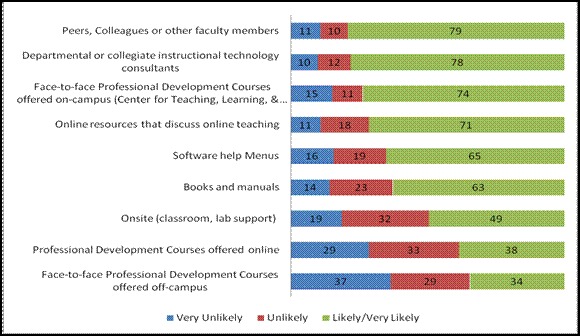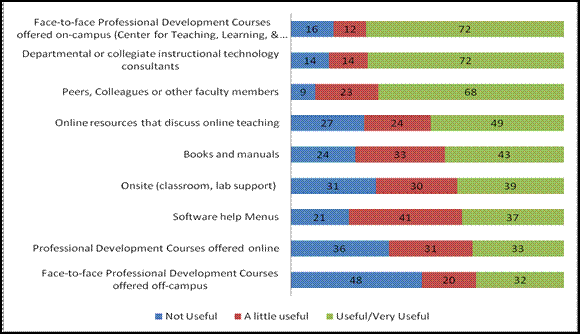| September 2010 Index | Home Page |
Editor’s Note: The Faculty is not a homogenous group of scholars, pedagogs, or educators. It is composed of individuals in many disciplines with unique experience and personalities, and with contrasting goals and philosophical positions. Departmentalization is an attempt to organize faculty who share common needs and interests by virtue of their discipline. Technology and distance learning do not necessarily focus common needs or close collaboration. This study looked at peer support and shared resources for online instruction.
Faculty Mentoring and Support
Among Online Instructors
Lydia Kyei-Blankson
USA
Abstract
Past research has shown that peer support helps improve several areas of faculty activities such as research, teaching, and technology competencies. Using a mixed method design, this research study investigated resources available to faculty as they teach or prepare to teach online at a large midwestern university. In addition, the study explored the nature of peer interactions that exists between faculty who taught or planned to teach online. The determinants of such interactions as well as the benefits and challenges involved in initiating and maintaining the interactions were examined. Findings from this study have implications for the development and implementation of training and support programs intended for faculty as they learn to teach online.
Background to the Study
Efforts to meet the demands of the 21st century learner have resulted in dramatic increases in the number of online courses offered by institutions of higher learning today. A large number of colleges and universities across the United States are now transitioning traditional face-to-face classes into fully online, blended, or web-facilitated courses in order to maintain a competitive edge and make classes accessible to a growing student population. The most current statistics suggest that almost 64 percent of all institutions offer at least one online course and 5 percent of all institutions offer at least one blended course (Allen, Seaman, & Garret, 2007). As a result, at some point in their teaching career, university instructors are asked to consider teaching their classes either partially or fully online (Clark-Ibanez & Scott, 2008).
The pathway of course migration to online environments often begins with the assumption that instructional designs, grading procedures, and other methods that typically work in the traditional classroom would remain the same in online settings. When faculty come to terms with the reality that these two environments are entirely different, they suddenly become frustrated (Franklin & Blankson, 2001) and realize the need for professional development activities and support programs that will help them teach successfully online.
Although these training programs have been useful, most of them have been offered in a similar manner with faculty attending one-time expert-led workshops which hardly include any follow-up activities (Crawford, 2003; Thompson, 2006). In addition, faculty participation in these one-time “one-size-fits-all” workshops does not necessarily ensure mastery of the desired skills required for effective online teaching (Bentley & Mumma, 1999).
In order to make courses ‘work’ online and to fully realize the promise of online teaching, Lan, Sheridan, Nelson, and Christensen (2002) suggest the need to encourage and cultivate interactions among groups of dedicated educators who are not only instructional leaders in their respective disciplines, but are also confident and self-sustaining technology users. Sorcinelli and Yun (2007) also encourage the building of networks of “multiple partners in nonhierarchical, collaborative, cross-cultural partnerships” (p. 58). Past research has shown that these interactions or support systems provide faculty with opportunities to draw on each others’ experiences and strategies which help improve several areas of faculty activities such as research, teaching, and technology competencies.
Statement of Need
With increases in the number of students enrolled in distance education courses, many instructors in U.S. institutions of higher education are being encouraged to teach online. In an effort to support faculty as they learn to teach online, college and universities are providing faculty with a variety of resources in the form of software and hardware, and training programs and activities. Another important resource for faculty is faculty-faculty interactions or support.
In general, considerable attention has been focused on studying the benefits and challenges of teaching online. Very few studies exist that have attempted to examine the extent to which resources are made available to faculty and the impact that these resources have had on online teaching. Hewett and Powers (2007) argue for the need to focus attention on the issue of training programs and activities that support faculty as they learn to teach online. Specifically, not much has been written on faculty-faculty interactions or support. Hewett and Powers suggest the need to gain an understanding of the interactions that occur among faculty who teach or intend to teach in online environments. The questions of interest here are to what extent do faculty who teach or prepare to teach online interact with each other and what is the effect of such interactions? The findings gathered from such a study will provide valuable information on how to structure professional development programs and support activities that ensure success as faculty teach and learn how to teach online.
Research Purpose and Questions
The purpose of this study was to examine the resources available to faculty who teach or plan to teach in online environments at a large Midwestern university and to explore the nature of faculty-faculty interactions that occur among instructors. The study also examined the determinants of faculty-faculty interactions and describes how these interactions are initiated and maintained.
The specific research questions this study seeks to address include the following:
What resources are available and considered useful to faculty as they prepare to teach or teach online at the Midwestern university?
To what extent do faculty-faculty interactions exist among instructors who teach or prepare to teach online and what is the nature of such interactions?
How are such faculty-faculty interactions initiated and maintained among instructors who teach or prepare to teach online?
What are faculty perceptions towards the impact of the faculty-faculty interactions on online teaching and what are the perceived benefits and challenges of such interactions?
What does it mean to teach Online?
Over the last couple of years the number of students enrolled in online courses has exploded. According to Allen & Seaman (2006), about one million more students were enrolled in at least one fully online course between 2005 and 2006. The benefits cited for online learning include increased opportunities for and access to learning, flexibility of scheduling for instructors and students, improved faculty-student interaction, and intense student participation (Clark-Ibanez, 2008).
Hewett and Powers (2004) conceptualize online teaching as the formal and informal delivery of pedagogic content via electronic formats such as the Internet, CD-ROM, videotape, and DVD. Kearsley (2000) also describes online teaching as any form of teaching that takes place via a computer network such as a local bulletin board system, the global internet, World Wide Web, local area network, or an intranet within a particular organization.
With online teaching gradually becoming commonplace in education, most institutions are investing in orientation and training to ensure faculty preparation to teach in this environment (Hewett & Powers, 2007). This is important even for courses that are offered partly online. According to Barker (2003), developing faculty to teach online is a complex challenge. Challenges identified include time spent learning to use new technologies, frustration with the malfunctioning of technology (Smith, 2001) and lack of institutional and peer support (Perreault, Waldman, Alexander, and Zhao, 2002). Other challenges include an underestimation of the time it takes to teach online and an overestimation of students’ technological skills and readiness for online courses.
What do instructors need to successfully teach in online environments?
Hewett and Powers (2007) argue for an increase in the assessment of what works in various online settings via theoretical and empirical research. Training faculty to teach in online environments necessitates investigation and reflection into the online training processes and experiences. Few discussions have been directed at the issues of preparing educators for online instruction directly.
In order for instructors to successfully teach in the online paradigm, a variety of support is required. Covington, Petherbridge, and Warren (2005) suggest the need for a triangulated approach which involves professional development opportunities, administrative support, and peer reassurance. Faculty motivation and commitment to teaching online were found to be higher in institutions where these support systems were well-provided (Kratz, 2003, Lee, 2001). Often instructional support is provided in the form of training in the use and application of distance education technologies, training in teaching methods, and media and technical support and course design support offered by instructional designers, editors, technicians, graphic designers, radio and/or television producers, teaching assistants, and librarians.
Method
A total of 117 faculty members (71% tenured and tenure-track, 21% non-tenure track, and 8% faculty) participated in the study. Faculty who teach fully or partly online or who are in the process of adopting online courses were contacted using recruitment letters which were distributed by way of campus email. Included in the email was a link to an online survey designed for the study. The survey consisted of both closed and open-ended items. Data collected by way of the closed-ended items were analyzed using descriptive statistics. The qualitative data collected were analyzed for themes, insights, commonalities, and differences (Patton, 2002).
Result and Discussions
The majority of the participants (76%) indicated that their commitment to teaching online was moderate to very strong (See figure 1). Some of the factors that influenced faculty’s decision to teach in an online environment included the following:
- Convenience - faculty can teach and students can take classes from any location
- Financial incentives
- Time- and cost-efficiency - Limited travel time involved for students and faculty.
- Opportunity for expanding in-class learning - Materials not covered during face-to-face class session can be delivered online
- Satisfaction of professional requirements for students
- Ease of course delivery - Subject being taught naturally lends itself and is more appropriate for online teaching
- Increased student interest in and demand for online learning- Students easily adapt to the Online system
- Encouragement from Campus Workshops and College Initiatives
- Positive learning experience for students - promotes collaboration among students, ensures more openness and honesty, and provides time for student reflection.
- Positive teaching experience- Instructors enjoy autonomy

Figure 1: Faculty commitment to teach in an online environment
Regarding the issue of availability of faculty resources, the majority of the faculty members (80%) stated that they were likely/very likely to seek assistance from their peers, colleagues, or other faculty when they taught or prepared to teach in online environments (see figure 2). In addition, 74% of instructors said they were likely/very likely to use the on-campus Center for Teaching, Learning, and Technology as a resource. On the other hand, only 35% and 39% indicated that they were likely/more likely to enroll in face-to-face professional development courses offered off-campus and in professional development courses offered online, respectively.
When asked about the usefulness of the resources available to them, 68% thought peers and other colleagues were useful/very useful resources while 72% thought the departmental instructional technology consultants were useful/very useful. On the other hand, only 33.3% thought that courses offered online were useful/very useful (see figure 3).
Focusing on the subject of interaction among faculty who taught or prepared to teach in online environments, most of the interactions were informal in nature; that is, they took place spontaneously in departmental hallways, during friendly office visits, by email correspondence, and by phone. On the other hand, some were formally initiated mostly during on-campus technology workshops and during departmental meetings arranged by the chair of the department. Faculty members who needed assistance were often the ones who sought out such interactions; yet surprisingly, at times, instructors who considered themselves experts in online environments initiated the contact and willingly offered to help. On other occasions, the head of department approached more experienced faculty and asked them to act as mentors to a “newer” faculty member. In some departments, the heads acted as tutors or consultants themselves.

Figure 2: Perceived likelihood of seeking assistance from this resource

Figure 3: Perceived faculty usefulness of resources
Faculty members considered peer interactions beneficial because they helped “build consistency within course offerings and coordination across the curriculum”. The interactions also ensured an easier and smoother transition of face-to-face classes online. Faculty learned new ideas during such dealings. Other faculty asserted that the interactions helped confirm things they were doing correctly in their courses and the meetings provided a space for airing their frustration and seeking moral support from others who were facing similar problems or issues. One faculty member summed it all up by saying:
“I think it helps build a community of learners (professional learning community). If we can't learn from one another, who can we learn from? I think the benefits of tying social interactions, fun, and learning together are wonderful. I get so emotionally and intellectually reinvigorated.”
Faculty stated, though, that peer interactions often times came with various challenges. These included the fact that faculty were always so busy it became so difficult to schedule time to meet regularly either formally or informally to discuss their needs. Also, at times some faculty found it difficult to relate to their peers because of the differences in teaching styles and levels (undergraduate to graduate). In addition, “some faculty like to work alone and are very defensive and exhibit proprietary behaviors when it comes to their work” making it difficult to learn from them. One instructor described her experience as follows: “I had a faculty member say to me in an open meeting that she wasn’t about to give me access to her course that she had worked so hard on so I could “steal” her work”.
The need for faculty support to create a successful teaching experience in online environments is clearly evident. Irrespective of these challenges, the data collected suggest that faculty perceive peer support, collaboration, and interactions to be very essential; so essential that as one faculty put it: “I would have liked the school to more actively arrange for the various online instructors to meet.”
References
Allen, I. E., Seaman, J., & Garret, R. (2007). Blending in. The extent and promise of Blended Education in the United States. Needham, MA: The Sloan Consortium.
Barker, A. (2003). Faculty development for teaching online: Educational and technological issues. The Journal of Continuing Education in Nursing, 34(6), 273-278.
Bentley, E. & Mumma, P. (1999). Taking the training wheels off: The use of mentoring for faculty development in the integration of technology. In J. Price et al. (Eds.), Proceedings of Society for Information Technology and Teacher Education International Conference 1999
(pp. 518-523). Chesapeake, VA: AACE.
Chuang, H., Thompson, A., & Schmidt, D. (2003). Faculty technology mentoring programs: Major trends in the literature. Journal of Computing in Teacher Education, 19, 101-6.
Clark-Ibanez, M., & Scott, L. (2008). Learning to teach online. Teaching Sociology, 36, 34-41.
Covington, D., Petherbridge, D., & Warren, S. E. (2005). Best practices: A triangulated support approach in transitioning faculty to online teaching. http://www.westga.edu/~distance/ojdla/spring81/covington81.htm
Crawford, C. (2003). Web-enhancing university coursework: An innovative professional development model to support a step-by-step approach towards web-enhancing courses and empowering instructors. International Journal on E-Learning, 2 (1), 5-13.
Franklin, T. & Blankson, J. (2001). Together and alone: The instructional, technical, and psychological outcomes of faculty building online courses. In C. Crawford et al. (Eds.), Proceedings of Society for Information Technology and Teacher Education International Conference 2001 (pp. 659-664). Chesapeake, VA: AACE.
Hewett, B., & Powers, C. E. (2007). Online teaching and learning: Preparation, development, and organizational communication. Technical Communication Quarterly, 16(1), 1-11.
Katz, R. N. (2003). Balancing technology and tradition: The example of course management systems. EDUCAUSE Review, 38(4), 48-54, 56-59.
Kearsley, G. (2000). Learning and teaching in cyberspace. Belmont , CA : Wadsworth.
Lan, J., Sheridan, K., Nelson, B., & Christensen, L. (2002). Mentoring: Support and reinforce
technology infusion through building relationships. A paper presented at the annual Society for Information Technology and Teacher Education (SITE) International Conference. Nashville, Tennessee.
Lee, J. (2001). Instructional support for distance education and faculty motivation, commitment, satisfaction. British Journal of Educational Technology, 32(2), 153-160.
Perreault, H., Waldman, L., Alexander, M., & Zhao, J. (2002). Overcoming barriers to successful delivery of distance learning courses. Journal of Education for Business, 77(6), 313-318.
Smith, L. J. (2001). Content and delivery: A comparison and contrast of electronic and traditional MBA marketing planning courses. Journal of Management Education, 23(1), 35-45.
Sorcinelli, M. D., & Yun, J. (2007). From mentor to mentoring networks: Mentoring in the new academy. Change: The Magazine of Higher Learning, 39(6), 58-61.
Thompson, D. (2006). Informal faculty mentoring as a component of learning to teach online: An exploratory study. Online Journal of Distance Learning Administration, 9 (3), 1-10.
About the Author
Lydia Kyei-Blankson is Assistant Professor in the Educational Administration and Foundations Department at Illinois State University. Her expertise and training is in research methods, applied statistics, and psychometrics. Her assignment at ISU includes teaching research methods and statistics graduate courses in the College of Education. Dr. Kyei-Blankson's research agenda focuses on the scholarship of teaching and learning and the implications of effective technology integration in teaching and learning.
Contact her at: lkyeibl@ilstu.edu